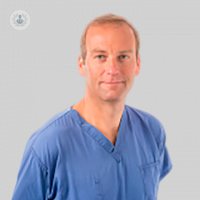Cartilage repair surgery: everything you need to know
Escrito por:Esteemed consultant orthopaedic surgeon Mr Paul Sutton provides an in-depth discussion on knee cartilage repair, explaining the various techniques used, recovery time and success rates.
What exactly is cartilage in the knee?
The term cartilage can be confusing because there are 2 different things inside the knee that are referred to as the cartilage.
The first, is a gristle-like structure that sits between the joint and is often compared to as a shock absorber. It can often be injured and then people may refer to it as a ‘torn cartilage’, however, the correct term is ‘torn meniscus’.

Within the knee there is a structure which is properly called cartilage, this is a smooth coating that is firmly fixed to the ends of the bone within the joint. The correct term for this is ‘articular cartilage’ and it works by allowing the joint surfaces to glide over each other like something on an icy surface. If damaged, it can cause pain and swelling. Damage to the articular cartilage can get progressively worse and lead to osteoarthritis, this is often referred to as ‘wear and tear’ arthritis.
When is surgery required to repair cartilage damage following a knee injury?
Surgery to repair cartilage damage in the knee may be necessary if non-surgical treatments such as physiotherapy, bracing, and medication have been unsuccessful in relieving pain and restoring function.
People who are involved in high levels of activity in sports or certain occupations often consider surgery. It may also be recommended for younger patients with severe cartilage damage as a method to try to prevent osteoarthritis.
What types of surgical procedures are used to repair damaged cartilage in the knee?
Various types of surgical procedures are used to repair damage to cartilage in the knee. The injury will be carefully investigated, usually with x-rays and an MRI. Following this, different treatments will be considered and the type chosen will depend on the extent and location of the injury.
Surgeons may discuss a range of treatments but not all of these options can reliably restore articular cartilage. The options that may be discussed include:
Micro-fracture. This involves making small holes or perforations in the bone under the area of damaged articular cartilage It is performed to allow bleeding into the defect, with the hope that it fills with a scar tissue called fibrocartilage.
It is an older method which is still considered by many surgeons. However, scientific evidence shows that it does not result in articular cartilage growing into the area of damage and the repair with scar tissue is poor. This means that it in general, it does not work well and its benefits do not last very long. I
In my opinion this technique is outdated, and I would rarely advise it. In addition to this it is important to consider that If this technique is used and is not successful, it means that the technique of Autologous Chondrocyte Implantation cannot be performed.
Osteochondral Autograft Transplantation (OATS): During this procedure, a small plug of healthy cartilage and bone is taken from one area of the knee and transplanted to the damaged area. It is an old technique which may still be considered in very specific circumstances but it is no longer commonly used, because it is unreliable and it involves taking bone and cartilage from a healthy part of the knee.
Fresh Osteochondral Allograft Transplantation (OCA): During this procedure, a graft of healthy cartilage and bone is taken from the knee of an organ donor and transplanted into the damaged area. It can be used for small or very large areas of damage and because the graft comes from an organ donor, there is no need to damage healthy tissue, unlike OATS. Within the NHS, this surgery can only be carried in specialised and commissioned centres.
Autologous chondrocyte implantation (ACI): This is a procedure in which a tiny biopsy of articular cartilage cells is taken from the patient's own knee. These cells are called chondrocytes and after their biopsy are then artificially grown in a laboratory. Normally, hundreds of thousands of cells are grown and these cells are all genetically identical to those of the individual patient. When enough cells have grown, they are implanted back into the damaged area. This technique has been proven to work well and provide good relief of symptoms. However, it is very specialised and can only be carried out in a very small number of hospitals. Additionally, it is not possible to use this technique in some patients because there are very strict criteria for its success. For example if a patient has already had a micro-fracture, then this technique can’t be used.
How long does it take to recover from cartilage repair surgery?
Recovery time after cartilage repair surgery can vary depending on the type of procedure and the patient's overall health. It is important to note that recovery is normally long and a full recovery can even be up to 2 years in some people.
Most patients will need to use crutches and a knee brace for several weeks following the surgery. Physical therapy will be necessary to regain strength, range of motion and function.
Can your knee fully recover after this type of surgery?
A knee can make a strong recovery after cartilage repair surgery, but it requires time, patience, and commitment to a rehabilitation program.
Patients must have realistic expectations and realise that sometimes the knee may not be able to return to the level of function it had pre-injury. However, with carefully considered and well executed surgery along with proper rehabilitation, patients could expect to return to a higher level, if not normal activities with reduced pain, less swelling and better overall function.
If you would like to book a consultation with Mr Sutton, do not hesitate to do so by visiting his Top Doctors profile today.


